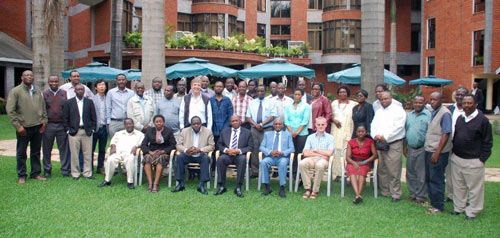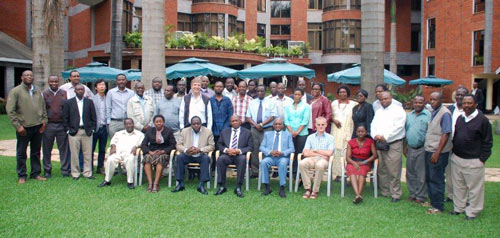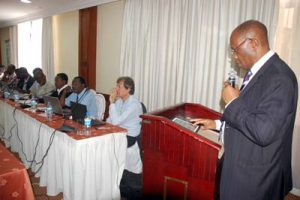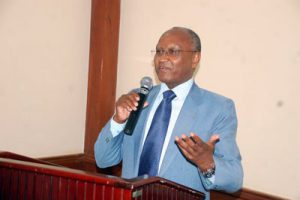
CIMMYT embarks on planning Meetings to kick-start Second Phase of SIMLESA

By Johnson Siamachira
From August to October 2014, CIMMYT held a series of SIMLESA planning and launch meetings in Malawi, Ethiopia and Tanzania.
The meetings were a follow-up to the launch of SIMLESA 2 held in Addis Ababa, Ethiopia, in July.
Representatives from the Australian Center for International Agricultural Research (ACIAR), Queensland Alliance for Agricultural and Food Innovation (QAAFI), the International Center for Tropical Agriculture (CIAT), the national agricultural research systems (NARS) of Ethiopia, Malawi, Mozambique, Kenya and Tanzania, and CIMMYT scientists from Ethiopia, Kenya and Zimbabwe met to finalize activities to meet the objectives of the second phase of the program.
The major objectives of the planning and launch meetings were to produce country-specific operational plans for the five SIMLESA countries. This involved realigning the countries’ activities to the overall SIMLESA I1 program plan.
CIMMYTY held the Malawi launch and planning meeting from 18 – 22 August. Dr. Mackson Banda, SIMLESA-Malawi Program Steering Committee member and acting director of the Department of Agricultural Research Services (DARS), and Bright Kumwembe, permanent secretary of the Ministry of Agriculture of Malawi, opened the meeting. Kumwembe expressed his gratitude to CIMMYT and SIMLESA’s contributions to improving food security in Malawi, and thanked ACIAR for funding SIMLESA.
The five – day meeting, attended by 50 people, was concluded by a field trip to Mitundu district. Although it was off-season, the visit was useful to the participants as it demonstrated practical examples and benefits of conservation agriculture.
Key outcomes of the Ethiopia meeting, held on 23 25 September, included a renewed commitment from the Ethiopian government and program partners to the program, and an improved understanding by the program partners of their roles and key work areas in the program.
Dr Eshetu Verso, deputy crop research director of the Ethiopian Institute of Agricultural Research, and guest of honor at the meeting, said SIMLESA had improved the production and productivity of smallholder farmers through productive and sustainable maize-legume systems. He urged the 45 participants to endorse SIMLESA 11 approval for the sustainability of the program.
Dr Mulugeta Mekuria, program coordinator said the second phase of SIMLESA would complement the achievements of the first phase, especially by scaling out good agricultural practices.
He said: “As we enter into the second phase of SIMLESA, we are taking stock of the successes and challenges of the previous phase. This will help us to plot the path for the next phase. We see this as presenting opportunities in current and future work. “
The joint meeting for the Kenya and Tanzania country teams, held in Arusha, Tanzania, from 14-17 October, was the third and last launch and planning meeting.

Dr Fidelis Myaka, director of research and development with the Tanzanian Ministry of Agriculture, Food Security and Cooperatives and guest of honor at the meeting, said SIMLESA was one of the pathways for Tanzania to meet its nutritional requirements and achieve food security for its population by 2050. Myaka, who is also a SIMLESA Project Steering Committee member, added that the project’s first phase focused on various technologies and improved the yield and productivity of smallholder farmers through sustainable maize-legume systems in the five core countries.
“Now, we need to upscale all these good experiences and the second phase is not an opportunity to be missed. The implementation of SIMLESA II will give all of us an opportunity to work with farmers to increase their production for sustainable food security and income,” Myaka told the 42 meeting participants.

George Mburathi, ACIAR consultant, said SIMLESA had a role to play in telling its own story to the outside world. “SIMLESA should proactively develop content for its publications to give smallholder farmers a voice. This way, you will help to involve various stakeholders by communicating for impact and influence.”
At the three planning and launch meetings, national coordinators from the five countries gave an overview of SIMLESA I products. Leaders of each of the four objectives highlighted the major changes to each objective in SIMLESA II. Cross-cutting areas such as gender mainstreaming and development communications were also highlighted as crucial to the success and impact for SIMLESA II. Participants developed work plans aligned to country priorities, which were linked to country financial budgets.
This last planning meeting meant that CIMMYT would now go “full throttle” to implement SIMLESA second phase.